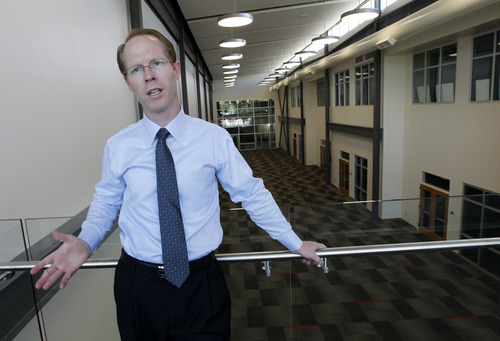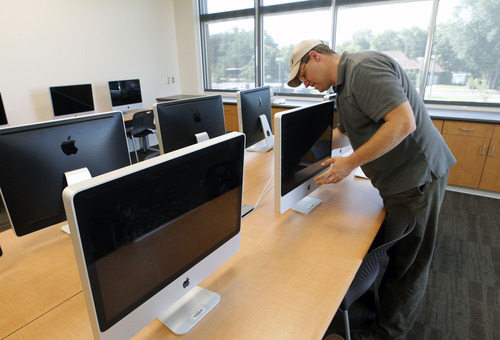This is an archived article that was published on sltrib.com in 2012, and information in the article may be outdated. It is provided only for personal research purposes and may not be reprinted.
The high school of the future might look something like this.
The school day has no beginning and no end. Classes go year-round. Students can learn in a variety of ways, including in traditional classrooms, through digital textbooks, at a community college and/or at a career and technical education center. Teachers and parents can track students' daily work and progress online.
That school of the future is opening this month in Salt Lake City in the form of Innovations High. Local and national experts say the approach may be one of the first of its kind in the country — a regular public school that allows students to build their own schedules, cherry-picking classes from Salt Lake Community College, the district's career and technical center, the district's traditional high schools, and the school's own face-to-face classes, which will be taught using digital textbooks through which students can move at their own speeds, on and off-campus.
For example, if students need help in a subject, they might sit in on classes at Innovations, at 1700 South and State Street, every day. Or, if they have great aptitude in a particular area, they might attend in that subject only once a week. Testing will be done in class.
"What we are trying to do in Salt Lake is create something that has not been created before," said Ken Grover, principal of Innovations and Salt Lake District director of secondary education support. "Students are allowed to dictate how they will take their coursework."
So far more than 90 teens in grades 9-12 have registered to start classes Aug. 22 at the free public high school.
—
Unique approach • The school's opening will represent the culmination of years of planning.
Grover said district leaders began about three years ago by looking at cutting-edge education models around the country. They liked the flexibility of online schools but disliked the lack of socialization for kids and face-to-face learning with teachers.
So they put what they admired into Innovations and added the elements they felt were missing from other traditional and online schools.
Michael Horn, executive director of the Innosight Institute, a nonprofit California-based think tank that studies innovation in education and other fields, said blending online and traditional learning to boost student achievement is a growing trend across the country. School districts mesh the two to save money, take advantage of students' technological know-how and better educate them, he said.
"They're seeing that, quite frankly, the current education system that's standardizing the way we teach and test just doesn't fit the needs of individual students," Horn said.
Horn, however, said he hasn't heard of another school exactly like Innovations — combining online, traditional, college and career and technical courses — anywhere in the nation.
It's also somewhat unique to see this approach taken on by a regular school district, not a private or charter school. Charter schools are independently run public schools. Grover said he hopes Innovations High shows public educators the power they have to creatively improve education.
"We'd like to keep the financial resources within our school districts," Grover said.
—
Weighing the choice • Grover said school leaders anticipated 30 kids might register for this year. But as of the end of July, more than three times that many had signed on, and registration continues.
He said this first year, the school can probably handle a maximum of about 180 students. Innovations plans to have one computer for each student, including some laptops for students to check out — an important option, considering about 60 percent of the district's students come from low-income families.
Interested parents and students have been visiting the school this summer. On a recent Monday, Ilona Gorogh and her daughter Miranda Fischer met with the school's counselor as they mulled whether to register.
Miranda, 15, doesn't enjoy having to wake up at the crack of dawn to attend classes that don't interest her at her traditional high school. She's partial to the idea of creating her own schedule, working at her own pace and taking law enforcement classes at the district's career and technical center, with which Innovations shares a building.
Her mother also believes the school could help prepare Miranda for college by having her make her own choices and organize her time.
"I know that my daughter sort of wants to control her own destiny," Gorogh said.
Miranda was undecided, however, at the end of the meeting, worrying that she might miss the social experience of high school. It will mostly be up to the Innovations student body whether to hold events like proms and dances. But students will be able to buy lunch at school and may join activities and sports teams at their traditional, boundary high schools, an assurance that made Miranda feel a bit better.
"You're not completely letting go," Miranda said.
It's one of a few things that means the school might not be right for every student. It also isn't ideal for special education students with severe disabilities or students who aren't self-motivated, Grover said.
—
Moving forward • As for the educational effectiveness of Innovation's mix of learning options, the jury is still out. There's not yet enough research to say whether the approach definitively helps students. But educators are optimistic.
Robyn Bagley, board chairwoman of Parents for Choice in Education, said she hopes traditional schools can learn from the new venture. She said she believes the flexibility and combinations of classes will entice kids who might otherwise drop out of school.
Grover said Innovations could help teens at all ends of the academic spectrum. He said traditional high schools are doing a great job with most kids — 76 percent of the Class of 2011 graduated, according to the State Office of Education.
But he said it's time to try new approaches to reach the kids for whom the traditional model doesn't fit.
"The idea was, what does education look like as it moves forward," Grover said, "and we think this is where it needs to be."
lschencker@sltrib.comTwitter: @lschencker —
Learn more about Innovations High
P To learn more about Innovations High, a new Salt Lake City School District public high school starting classes later this month, go to innovations.slcschools.org or call 801-598-7253. The school is located at 1700 South and State Street in Salt Lake City, next door to Salt Lake Community College's South City campus.







